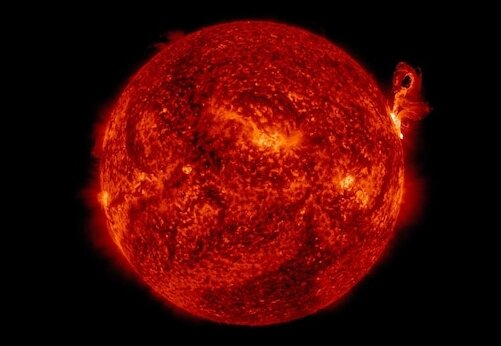
Giant solar fire likely to hit Earth soon

A massive solar flare erupted from the sun on June 14 and is about to hit Earth on Tuesday (July 19), space agencies have reported.
The US-based National Oceanic and Atmospheric Administration (NOAA) had raised an alert that the flare headed toward the planet could cause a massive solar storm and had the potential to cause a radio blackout.
As per reports, the warning came from scientist Tamitha Skov, a space weather physicist who had predicted the storm using the NASA forecast model.
The scientist shared the prediction on Twitter, describing the solar flare as a filament in the shape of a snake advancing towards Earth.
The long snake-like filament cartwheeled its way off the #Sun in a stunning ballet. The magnetic orientation of this Earth-directed #solarstorm is going to tough to predict. G2-level (possibly G3) conditions may occur if the magnetic field of this storm is oriented southward! pic.twitter.com/SNAZGMmqzi
— Dr. Tamitha Skov (@TamithaSkov) July 16, 2022
She said: “Direct hit! A snake-like filament launched as a big solar storm while in the Earth strike zone. NASA predicts early July 19. Strong aurora shows possible with this one, deep into mid-latitudes. Amateur radio and GPS users expect radio disruptions on Earth’s nightside.”
The scientist also predicted that “G2 (possibly G3) conditions may occur if the magnetic field of the storm is oriented southward”.
Solar eruptions are usually classified on basis of intensity with A being the least powerful and X being the most powerful.
Also Read: Biggest, brightest Supermoon of 2022 to lighten up skies on July 13
As per reports, the huge ball of fire that erupted from the Sun’s surface is around 155,000 miles long and 15,500 miles deep.
Disruptions in air travel and GPS systems are likely to be experienced as the Ionosphere often gets ionised by such radiations. Northern lighting will also be experienced in some places, predict space scientists.
The space scientist Skov confirmed on Twitter the formation of aurora lights in Alberta, Canada during the building solar storm. She has also predicted a similar light show to be observed over Tasmania and News Zealand on Tuesday night.
What are solar flares?
Solar flares are a sudden explosion of energy caused by tangling, crossing or reorganising magnetic field lines near the sunspots, areas of the Sun which are comparatively cooler than other parts on its surface.
Solar activity varies with the stages in a solar cycle and tends to increase when the Sun is in its active phase.
How do solar flares affect Earth?
Solar flares are often accompanied by a coronal mass ejection (called CME) which are huge bubbles of radiation and particles from Earth. They explode into space at very high speed when the Sun’s magnetic field lines suddenly reorganize.
When charged particles from a CME reach Earth, they can trigger intense lights in the sky, called auroras. When particularly strong, a CME can also interfere in power utility grids, which at their worst can cause electricity shortages and power outages.
Solar flares and CMEs are the most powerful explosions in our solar system.
Skov explains that there is a scale to measure the strength of these geomagnetic storms and they range from level G1 to G5, in order to analyse the intensity and effects of the storms.


